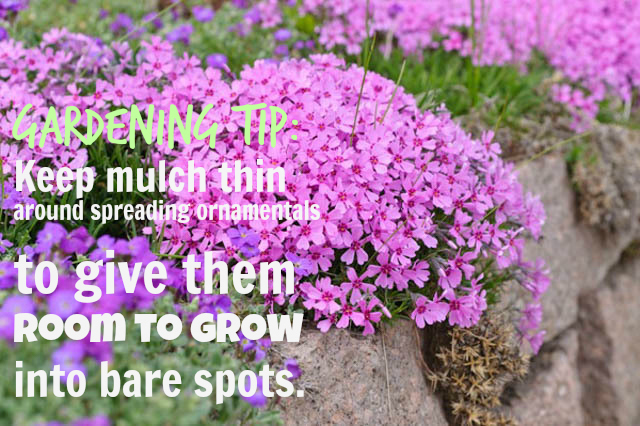
Like many gardening decisions, whether to use landscape fabric is largely dependent on the situation. Sometimes it can come in handy and sometimes it can create extra work. If you are thinking about using landscape fabric for your next project, here are a few factors we think are worth considering:
THE PROS
1) Weeding can seem so labor-intensive that when landscape fabric became widely available, many professionals and hobbyist gardeners alike thought it would be the gardening version of sliced bread.
2) Vegetable gardeners sometimes use the same sheets of landscape fabric year after year, lifting them up to prepare the soil then replacing them and using the original holes as a planting guide. Adding a light layer of mulch over top of the landscape fabric keeps moisture in and protects the fabric from damaging sun.
3) Landscape fabric can also help prevent soil erosion. When topped by a relatively immobile layer like rocks, the fabric can help prevent soil erosion on steep slopes.
4) In shrub beds, where little change is anticipated, landscape fabric can serve as an effective barrier to germination and growth of seeds already in the soil. When planting a garden in which it is desirable to have very discrete clumps of perennials, it can keep those that tend to spread in check for a while, anyway…. until the fabric starts to break down. This leads us to the cons of using landscape fabric!
THE CONS
1) And break down it does. Depending on the fabric and environment, this may take three years, or it may take ten. Then you can have a situation where you are pulling out plants (ornamentals and/or weeds) that have roots and stems so enmeshed in the fabric that they can’t be composted. The longer-lasting, heavier fabrics often have a lower water infiltration rate. This brings us to some of the downsides of landscape fabric.
2) Not only does landscape fabric serve as a barrier to weeds, the fabric impedes organic matter from the breakdown of wood mulches from being incorporated into the soil, leading to compaction, nutrient depletion, and an environment not amenable to beneficial soil organisms. Heavy fabrics, and those which have had layers of wood mulch added over the years, can even lower the amount of oxygen getting to roots and create conditions of constant excessive moisture leading to root rot. I’ve often picked up an old fabric layer to find the underside plastered with a network of roots of ornamentals that have been struggling to reach favorable conditions for growth.
3) One particularly annoying aspect of landscape fabric is that it can make weeding more difficult! Grass can grow under the fabric, establishing a network of roots that is impossible to eradicate without herbicide or lifting up the fabric barrier. The grass can then send shoots right through at least some fabrics (and those that are beginning to deteriorate), or grow in the holes cut for planting of ornamentals. Weeds with strong taproots, such as dandelions and thistles, can either re-grow from parts of roots left in the soil before the fabric was laid then penetrate it from below, or germinate in mulch and send roots right through the fabric.
In short, it pays to think ahead when considering landscape fabric, taking into account site factors and goals. While in some instances it can be helpful, I echo an earlier post we wrote last season (Tip #1 for a Tidy Garden): Landscape fabric is often more labor and expense than it’s worth.
Happy gardening!
-Kristi
